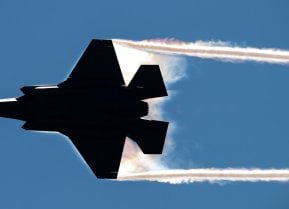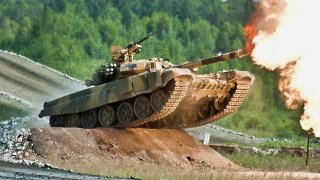The Eclipse of the Russian Arms Market
Once a leader in global weapons exports, Russia’s arms shipments to the outside world have considerably slimmed due to Moscow’s overwhelming need to continue supplying the war in Ukraine.
Scholars and commentators have published numerous analyses of the 2023 Stockholm International Peace Research Institute (SIPRI) reports on defense expenditures and imports and exports for countries across the world. Overall, the top five weapons exporters remain the same: the United States, France, Russia, China, and Germany. However, the data showcases a subtle but important shift: Russia’s international share of arms exports is being challenged by France, China, and South Korea. In fact, Russia lost its status as the number two arms exporter for the first time in decades.
Cracks in Russia’s defense industrial base have emerged. Despite improvements in Russian munitions production and its outpacing of U.S. and European production by a three-to-one ratio, Russian production fails to meet demands. Russia’s increase in production, coupled with the delivery of tanks and armored vehicles, is simultaneously a testament to the mobilization of its industrial base and an indication of its weakness. A recent RUSI report shows that 80 percent of the tanks and armored fighting vehicles Russia delivered are just refurbished or modernized old equipment.
Production issues caused Russia to suspend its deliveries to India, which is historically Russia’s largest client by value. Despite a steady decline in Russian imports starting in the mid-2010s, India still relies heavily on Russian kits. Russia delayed the delivery of small arms for the Indian Army, the S400 Triomf Surface-to-Air Missile System, and two Krivak-V Class Missile Frigates to the Indian Navy. As similar reports on the inability to deliver arms emerge, such as Armenia’s 2023 claim that Russia failed to complete multiple contracts, it will only further undermine the perception of Russian industrial reliability.
The overall global rankings for 2023 show that France and Russia have switched places from the 2022 report, revealing Russia’s decline in the overall export market. However, France is supplying clients who want high-tech, expensive, new equipment like fighter aircraft, surface ships, and submarines. A look at the specific equipment shows that France exported more combat aircraft in 2023 (France: 223; Russia: 78), which maintains the French lead in 2022 (France: 210; Russia 84). France has also maintained a lead in warships from 2022 (France 21; Russia 5) to 2023 (France 20; Russia 5). The decline in Russian aircraft deliveries largely accounts for France’s vaulting over Russia’s long-held second position.
Russia’s slide denotes another important trend: alternative suppliers are creeping into the international value arms market. The value arms market consists of older technology platforms, used or new but affordable. The lower cost of value arms has resulted in their use across global battlefields and comprises large portions of hundreds of countries’ military arsenals. We examine how China is increasingly supplying the lower end of the value arms market, overtaking Russian market share and expanding China’s geopolitical reach. In the higher end of the value arms market, South Korea is increasing its exports of new, higher-end capabilities, further eroding Russia’s global position. Russia’s decline in global export share will continue, as its position as a global arms exporter is challenged by China expanding into lower-income countries and South Korea expanding into the middle-income market.
China and the Value Arms Market
Countries purchasing from the value arms market can either buy from it alone or augment their value arms with selected high-price capabilities (e.g., fighter jets). Our preliminary analysis of the value arms market segment reveals China is entering the market for traditional Russian products.
Recently, China has usurped Russian export totals in land warfare platforms like tanks, armored vehicles, and howitzers. Assuming these deliveries occur—as opposed to contracts that can be modified or remain unfulfilled—the data on armored vehicle transfers from SIPRI shows a major change in the past two years. In 2022, following the full-scale invasion of Ukraine, Russia delivered 186 armored vehicles, while China delivered 137 of them. However, in 2023, the last year data was available, Russia delivered 90 armored vehicles while China delivered 235.
Russia is also ceding market share in sub-Saharan Africa to Chinese value arms. According to SIPRI, China overtook Russia in 2023 as the largest exporter to the sub-Saharan Africa region. China’s overall share of the worldwide arms exports market was 5.8 percent, with its primary customers being Pakistan, Bangladesh, and Thailand. Pakistan and Thailand import both value arms and high-tech expensive equipment from manufacturers in Europe and the United States, while Bangladesh almost exclusively procures from the value market.
China can also expand into new markets in Latin America by leveraging its burgeoning trade relations: it is the top trading partner of South American countries and the second largest one in Central America. Aside from trade, it also has ideological allies in the incumbent leaders of Bolivia, Colombia, Venezuela, and Nicaragua. Venezuela stands out as it has had a history of procuring Chinese defense equipment from armored vehicles like the VN-4, light attack aircraft like the K-8, and radars like the JY-11. A third reason countries like Peru prefer Chinese equipment is because of their similarities to Soviet-Russian ones that it has a history of operating.
South Korea Brings Value in the High-End Market
South Korea is positioning itself as Russia once did—the cheaper alternative to American higher-priced equipment. South Korea is exporting more land platforms than Russia and China combined. For example, South Korea sold 1,113 tanks and armored vehicles in 2022 and 1,581 in 2023. South Korea’s emergence as an arms supplier is even more stark when comparing artillery systems. In 2023, South Korea exported 1,233 systems, while China exported more than 126 systems, and Russia exported none. In 2022, South Korea exported 1,232 systems, while China exported 128, and Russia exported none. In fact, in artillery systems, South Korea exported more than the other 9 top exporters—in the high-tech and value arms markets—combined in 2022 and 2023.
South Korea demonstrates how manufacturing quality and the variation in prices condition export growth. For example, South Korea’s K9, 155mm self-propelled howitzer, is significantly cheaper than its German counterparts, yet it is still more expensive than the Chinese SH-15 and the French Ceasar. This is due in part to the prominence of artillery in the Russia-Ukraine War. Elevated demand facilitates a dynamic market with competition among players. Poland’s purchase of 150 K9s for an estimated $2.6 billion cements South Korea’s competitiveness in this market. Critical in any defense deal, South Korea will provide training, logistical support, and munitions as part of the contract. These long-term engagements, be they for training or sustainment and logistics, bind militaries and bureaucracies together. Updates and modification packages during follow-up periods further extend the collaboration time window. South Korea’s February 2024 announcement of a 50 percent increase in the range of the 155mm Extended-range munitions is just one instance of how innovation will continue to invigorate exports.
South Korea is establishing itself as a viable alternative to Russian and American capabilities. South Korea’s combination of rapid production rate, sometimes years faster than similar American production rates, and ability to produce NATO-compatible weapons fortifies their export-oriented defense industrial base. South Korea’s sale of the K2 Black Panther to Poland and a potential production collaboration with Turkey will sustain production rates. In terms of pricing, the K2 is expected to have lower maintenance costs than the American M1 tank, though the unit price is comparable. Signaling South Korea’s movement into the high-end market, the K2 is more expensive than Germany’s Leopard 2 and Britain’s Challenger 2.
In the armored personnel carrier market, a market that is perhaps the closest to a commodity in the land platform arena, South Korea’s K21 IFV costs less than the American M2A4 Bradley. However, it is still more expensive than Russia’s BMP-3. Latvia greenlit the consideration of the K21 for its infantry fighting vehicle replacement program. Hanwha Aerospace, the K21 manufacturer, is competing against ASCOD, which is jointly developed by Austria and Spain and Turkey’s Otokar-manufactured Tuplar. Successful export deals with Australia, Poland, and Saudi Arabia have elevated South Korea’s international reputation as a cost-effective alternative arms supplier.
Two characteristics of South Korea’s defense industrial base pose long-term challenges for Russia. First, South Korea manufactures at a scale that allows high rates of production. While this is a boon for NATO and other importing countries, particularly as the U.S. struggles with rates of production across its defense industrial base, Russia’s strategic position as a reliable value arms supplier will continue to be pressured as it struggles to make deliveries. Second, South Korea’s military means have overcome a significant barrier in the international arms market—reliability concerns. American-made equipment is expensive for a host of reasons, but one critical reason is its dependability based on rigorous development, manufacturing, and maintenance standards. The inclusion of South Korean equipment in NATO exercises and the export to NATO allies suggests technical interoperability that further bolsters the reputation of South Korean-produced military means.
When do Cracks Become Fissures?
Russia’s negative reputational consequences of invading Ukraine, combined with the poor, inconsistent performance of the Russian military, the impact of Western economic sanctions, and domestic production limitations, are impediments to exports with potentially limited time horizons. However, Russia remains sufficiently resilient against Western sanctions to continue defense manufacturing. Russian augmentation of its industrial base via the acquisition of machine tools and other dual-use technology, as well as concentrated defense industry investment, has increased the rate of production of several vital military capabilities used in Ukraine, including ammunition.


